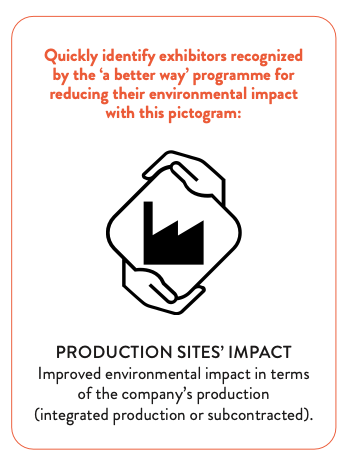‘a better way’ programme criteria #2: Impact of production sites The - Première Vision Paris
For nearly 50 years Première Vision has served as the central hub of the upstream fashion industry, a catalyst fostering connections, exchanges, and discoveries. With the introduction of its innovative “a better way” programme, the show is committing to driving the sector’s transformation by sharing key analyses of the environmental and social performance of its exhibitors.
The program is based on 5 criteria: Social initiatives, Impact of production sites, Traceability, Composition, and Product life cycle and end-of-life. Five questions are used to assess how robustly each of these key areas is managed.
Here, a look at the issues covered by the pillar dealing with Production sites’ impacts.
1- ISO 14001, EMAS and LWG Certification
ISO 14001
ISO 14001 is an international environmental management standard which aims for continuous improvement. The standard sets out a framework for implementation, starting with a baseline survey to analyze environmental impact, identify and draw up an environmental action plan, prioritize solutions, and control and monitor the effectiveness of the system implemented.
In this way, operational risks are minimized and environmental performance gradually improved.

EMAS (Eco Management and Audit Scheme)
Developed by the European Commission, EMAS goes beyond the expectations of ISO 14001, helping companies to assess, improve and communicate their environmental performance.
Criteria include compliance with environmental legislation, continuous improvement of environmental performance, and publication of an environmental statement. The data is summarized in a publicly available annual report. These three elements must be validated by an external auditor. If the environmental management system complies with requirements, the company can then be EMAS-registered.
LWG (Leather Working Group)
A benchmark certification for responsible tanneries, LWG evaluates numerous environmental management parameters. It reviews the traceability of hides all the way to the slaughterhouse, the control of chemical substrates and regulated heavy metals, the evaluation of energy per production unit, the measurement of water consumption, the management of air and noise emissions, the management of solid waste and effluent treatment, the evaluation of social responsibility and health and safety risks on production sites. 3 grades, bronze, silver and gold, characterize tanneries according to their audit results.
2- Use of at least 50% renewable or site-generated energy
The raw materials processing stages generate significant energy consumption. Energy mixes vary from country to country, and include fossil, nuclear and renewable energies.
To achieve the European Union’s objective of reducing CO2 emissions by 55% by 2030 (compared with 1990 levels), it is necessary to reduce GHG emissions from the energy sector. Choosing renewable energies makes it possible to contribute to energy transition. In particular, installing solar panels enables production units to generate their own low-impact energy.

3- OEKO-TEX standard 100 or RSL (Restricted Substances List) certification: going beyond the regulatory requirements of the country of production.
Chemical substances are present throughout the transformation of raw materials into fabrics or leather, and then into finished products.
The European REACH regulation protects human health and the environment from the risks associated with chemical substances. The ‘a better way’ programme highlights initiatives that go beyond local legislation.
The adoption of an MRSL (Manufacturing Restricted Substances List) makes it possible to voluntarily extend controlled or excluded substances to ensure an additional level of safety.
Oeko-tex standard 100 certification sets out a catalogue of criteria, reviewed at least once a year, that go beyond regulatory requirements to guarantee the safety of the products tested.
4- Treatment and reuse of production water
Water consumption is particularly high in the dyeing and finishing stages. In many countries, regulations on effluent treatment are not very stringent, or even non-existent. It is essential to ensure principled treatment of wastewater, which is loaded with impurities, chemical substances, heavy metals, oils, greases, salts and other pollutants.
‘a better way’ surveys suppliers on the presence of a wastewater treatment system and the optimization of water resources, requiring a minimum of 50% of water reused within production units.
5- Waste management
Waste management aims firstly to reduce volume, secondly to revalorize by-products through an efficient sorting system, and lastly to ensure that they are disposed of when they cannot be reused or are hazardous.
Waste can be reused through dedicated organizations, energy recovery, open-loop recycling as insulation material, for example, or closed-loop recycling to produce new textiles. Hazardous industrial waste must be directed towards specific treatment channels, via approved collectors.
Environmental management is a key pillar of a responsible approach. While material resources have long been the key to responsible approaches, it is just as essential to understand and optimize environmental performance throughout the materials processing chain. Traceability makes it possible to establish the link between these components, with the identification of origin and data on the various stages of production, from the extraction of raw materials to their end-of-life.
The next Traceability pillar will highlight how ‘a better way’ showcases the initiatives of Première Vision exhibitors who are committed to traceability throughout the value chain.
Find out more about the ‘a better way’ program and discover the 5 criteria in detail:
